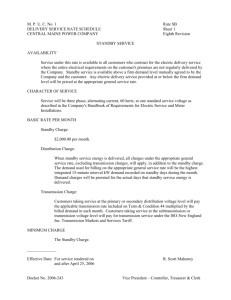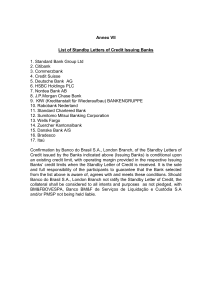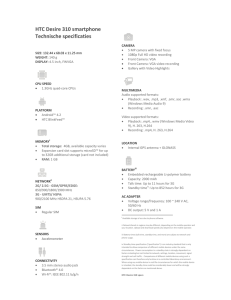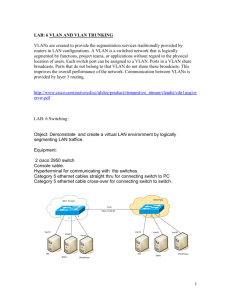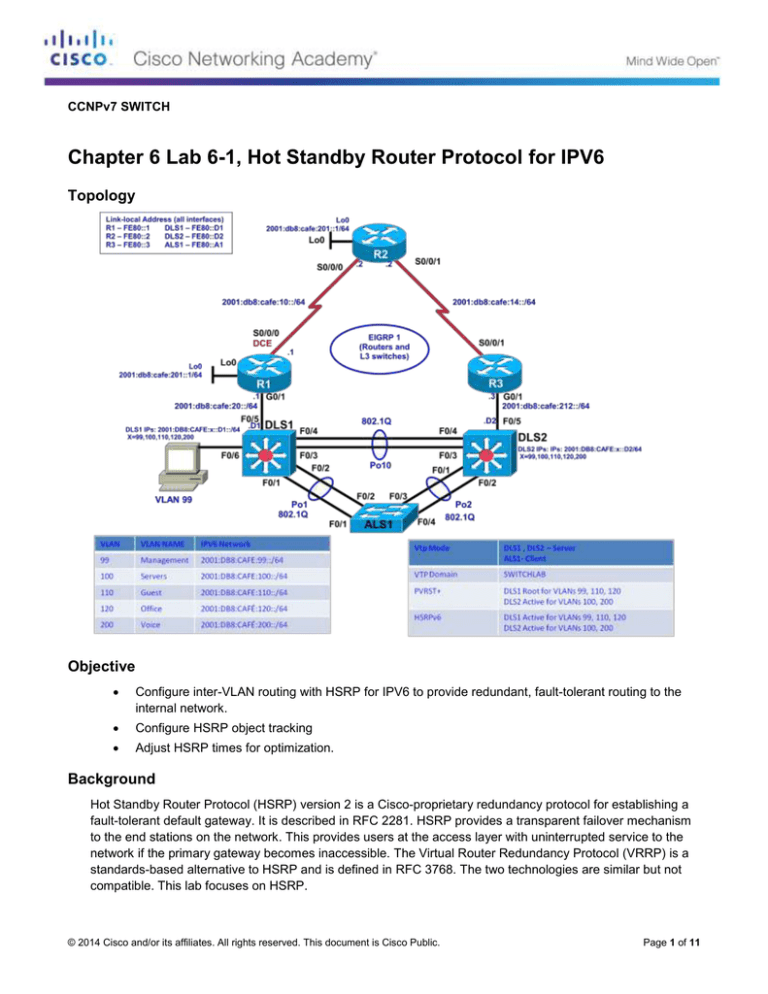
CCNPv7 SWITCH
Chapter 6 Lab 6-1, Hot Standby Router Protocol for IPV6
Topology
Objective
Configure inter-VLAN routing with HSRP for IPV6 to provide redundant, fault-tolerant routing to the
internal network.
Configure HSRP object tracking
Adjust HSRP times for optimization.
Background
Hot Standby Router Protocol (HSRP) version 2 is a Cisco-proprietary redundancy protocol for establishing a
fault-tolerant default gateway. It is described in RFC 2281. HSRP provides a transparent failover mechanism
to the end stations on the network. This provides users at the access layer with uninterrupted service to the
network if the primary gateway becomes inaccessible. The Virtual Router Redundancy Protocol (VRRP) is a
standards-based alternative to HSRP and is defined in RFC 3768. The two technologies are similar but not
compatible. This lab focuses on HSRP.
© 2014 Cisco and/or its affiliates. All rights reserved. This document is Cisco Public.
Page 1 of 11
Chapter 5 Lab 5-1, Hot Standby Router Protocol
Note: This lab uses Cisco ISR G2 routers running Cisco IOS 15.4(3) images with IP Base and Security packages
enabled, and Cisco Catalyst 3560 and 2960 switches running Cisco IOS 15.0(2) IP Services and LAN Base
images, respectively. The switches have Fast Ethernet interfaces, so the routing metrics for all Ethernet links in
the labs are calculated based on 100 Mb/s, although the routers have Gigabit Ethernet interfaces. The 3560 and
2960 switches are configured with the SDM templates “dual-ipv4-and-ipv6 routing” and “lanbase-routing”,
respectively. Depending on the router or switch model and Cisco IOS Software version, the commands available
and output produced might vary from what is shown in this lab. Catalyst 3650 switches (running any Cisco IOS
XE release) and Catalyst 2960-Plus switches (running any Cisco IOS image) can be used in place of the Catalyst
3560 switches and the Catalyst 2960 switches.
Required Resources
1 switches (Cisco 2960 with the Cisco IOS Release 15.0(2)SE6 C2960-LANBASEK9-M image or
comparable)
2 switches (Cisco 3560 with the Cisco IOS Release 15.0(2)SE6 C3560-IPSERVICESK9-M image or
comparable)
Ethernet and console cables
1 PC
Part 1: Prepare for the Lab
Step 1: Prepare the switches for the lab
Use the reset.tcl script you created in Lab 1 “Preparing the Switch” to set your switches up for this lab.
Then load the file BASE.CFG into the running-config with the command copy flash:BASE.CFG
running-config. An example from DLS1:
DLS1# tclsh reset.tcl
Erasing the nvram filesystem will remove all configuration files! Continue? [confirm]
[OK]
Erase of nvram: complete
Reloading the switch in 1 minute, type reload cancel to halt
Proceed with reload? [confirm]
*Mar 7 18:41:40.403: %SYS-7-NV_BLOCK_INIT: Initialized the geometry of nvram
*Mar 7 18:41:41.141: %SYS-5-RELOAD: Reload requested by console. Reload Reason:
Reload command.
<switch reloads - output omitted>
Would you like to enter the initial configuration dialog? [yes/no]: n
Switch> en
*Mar 1 00:01:30.915: %LINK-5-CHANGED: Interface Vlan1, changed state to
administratively down
Switch# copy BASE.CFG running-config
Destination filename [running-config]?
184 bytes copied in 0.310 secs (594 bytes/sec)
DLS1#
© 2014 Cisco and/or its affiliates. All rights reserved. This document is Cisco Public.
Page 2 of 11
Chapter 5 Lab 5-1, Hot Standby Router Protocol
Step 2: Configure basic switch parameters.
Configure an IP address on the management VLAN according to the diagram. VLAN 1 is the default
management VLAN, but following best practice, we will use a different VLAN. In this case, VLAN 99.
Enter basic configuration commands on each switch according to the diagram. Each interface should be
configured with a global unicast address and a statically assigned link-local address. Please refer to the
table on the topology diagram for the address information.
DLS1 example:
DLS1# configure terminal
DLS1(config)# interface vlan 99
DLS1(config-if)# ipv6 address 2001:DB8:CAFE:99::D1/64
DLS1(config-if)# ipv6 address fe80::d1 link-local
DLS1(config-if)# no shutdown Enter configuration commands, one per line.
CNTL/Z.
End with
The interface VLAN 99 will not come up immediately, because the layer 2 instance of the vlan has not yet
been defined. This issue will be remedied in subsequent steps.
(Optional) On each switch, create an enable secret password and configure the VTY lines to allow remote
access from other network devices.
DLS1 example:
DLS1(config)# enable secret class
DLS1(config)# line vty 0 15
DLS1(config-line)# password cisco
DLS1(config-line)# login
Note: The passwords configured here are required for NETLAB compatibility only and are NOT
recommended for use in a live environment.
Note(2): For purely lab environment purposes, it is possible to configure the VTY lines so that they accept
any Telnet connection immediately, without asking for a password, and place the user into the privileged
EXEC mode directly. The configuration would be similar to the following example for DLS1:
DLS1(config)# enable secret class
DLS1(config)# line vty 0 15
DLS1(config-line)# no login
DLS1(config-line)# privilege level 15
Step 4: Configure trunks and EtherChannels between switches.
EtherChannel is used for the trunks because it allows you to utilize both Fast Ethernet interfaces that are
available between each device, thereby doubling the bandwidth.
Note: It is good practice to shut down the interfaces on both sides of the link before a port channel is created
and then re-enable them after the port channel is configured.
a. Configure trunks and EtherChannels from DLS1, DLS2, and ALS1 according to the diagram. Use PaGP
as the negotiation protocol for EtherChannel configurations. **Refer to diagram for port channel numbers.
DLS1(config)# interface range fastEthernet 0/1-2
DLS1(config-if-range)# switchport trunk encapsulation dot1q
DLS1(config-if-range)# switchport mode trunk
DLS1(config-if-range)# channel-group 1 mode desirable
© 2014 Cisco and/or its affiliates. All rights reserved. This document is Cisco Public.
Page 3 of 11
Chapter 5 Lab 5-1, Hot Standby Router Protocol
DLS1(config-if-range)# no shut
Creating a port-channel interface Port-channel 1
b. Verify trunking and etherchannel configurations between all switches with the appropriate trunking and
etherchannel verification commands.
Step 5: Configure VTP on all switches according to the VTP information on the diagram.
a. A sample configuration is provided for you.
DLS2(config)# vtp mode server
Setting device to VTP Server mode for VLANS
NOTE: Switches default to vtp mode server. However, remember the base
configuration modifies this setting to vtp mode transparent.
Repeat similar configurations on ALS1.
b. Verify the VTP changes.
Step 6: Configure VTP on DLS1.
Create the VTP domain on VTP server DLS1 and create VLANs 99, 100, 110, 120, 200, for the domain.
NOTE: Switches default to vtp mode server. However, remember the base configuration modifies this
setting to vtp mode transparent.
DLS1(config)# vtp domain SWITCHLAB
DLS1(config)# vtp version 2
DLS1(config)#vtp mode server
Setting device to VTP Server mode for VLANS
DLS1(config)# vlan
DLS1(config-vlan)#
DLS1(config-vlan)#
DLS1(config-vlan)#
DLS1(config-vlan)#
DLS1(config-vlan)#
DLS1(config-vlan)#
DLS1(config-vlan)#
DLS1(config-vlan)#
DLS1(config-vlan)#
c.
99
name
vlan
name
vlan
name
vlan
name
vlan
name
Management
100
Servers
110
Guest
120
office
200
Voice
Verify that VLANs propagated to the other switches in the network.
Step 8: Configure HSRPv6 interfaces and enable IPV6 routing with EIGRP.
HSRP provides redundancy in the network. The VLANs can be load-balanced by using the standby group
priority priority command. The ipv6 unicast-routing command is used on DLS1 and DLS2 to
activate ipv6 routing capabilities on these Layer 3 switches.
Each route processor can route between the various SVIs configured on its switch. In addition to the real IP
address assigned to each distribution switch SVI, assign a third IP address in each subnet to be used as a
virtual gateway address. HSRP negotiates and determines which switch accepts information forwarded to the
virtual gateway IP address.
© 2014 Cisco and/or its affiliates. All rights reserved. This document is Cisco Public.
Page 4 of 11
Chapter 5 Lab 5-1, Hot Standby Router Protocol
The standby command configures the IP address of the virtual gateway, sets the priority for each VLAN, and
configures the router for preempt. Preemption allows the router with the higher priority to become the active
router after a network failure has been resolved. Standby version 2 must be implemented for support of
HSRPv6. The standby x ipv6 autoconfig command, where x is the assigned HSRP group number, is
used to assign the group an automatically generated virtual ipv6 address.
In the following configurations, the configured priority for VLANs 99, 110, and 120 is 110 on DLS1, making it
the active router for those VLANs. VLANs 100 and 200 have a default priority of 100 on DLS1, making DLS1
the standby router for these VLANs. DLS2 is configured to be the active router for VLANs 100 and 200 with a
configured priority of 110, and the standby router for VLANs 99, 110, and 120 with a default priority of 100.
Note: It is recommended that the HSRP group number be mapped to VLAN number.
DLS1(config)# ipv6 unicast-routing
DLS1(config)# ipv6 router eigrp 1
DLS1(config-router)# no shutdown
DLS1(config-router)# router-id 1.1.1.1
DLS1(config)#
DLS1(config)#
DLS1(config)#
DLS1(config)#
DLS1(config)#
interface FastEthernet0/5
no switchport
ipv6 address FE80::D1 link-local
ipv6 address 2001:DB8:CAFE:20::D1/64
ipv6 eigrp 1
DLS1(config)# interface vlan 99
DLS1(config-if)# standby version 2
DLS1(config-if)# standby 99 ipv6 autoconfig
DLS1(config-if)# standby 99 priority 110
DLS1(config-if)# standby 99 preempt
DLS1(config-if)# ipv6 eigrp 1
DLS1(config-if)# exit
DLS1(config)# interface vlan 100
DLS1(config-if)# ipv6 address 2001:DB8:CAFE:100::D1/64
DLS1(config-if)# ipv6 address FE80::D1 link-local
DLS1(config-if)# standby version 2
DLS1(config-if)# standby 100 ipv6 autoconfig
DLS1(config-if)# standby 100 preempt
DLS1(config-if)# ipv6 eigrp 1
DLS1(config)# interface vlan 110
DLS1(config-if)# ipv6 address 2001:DB8:CAFE:110::D1/64
DLS1(config-if)# ipv6 address FE80::D1 link-local
DLS1(config-if)# standby version 2
DLS1(config-if)# standby 110 ipv6 autoconfig
DLS1(config-if)# standby 110 priority 110
DLS1(config-if)# standby 110 preempt
DLS1(config-if)# ipv6 eigrp 1
DLS1(config)# interface vlan 120
DLS1(config-if)# ipv6 address 2001:DB8:CAFE:120::D1/64
DLS1(config-if)# ipv6 address FE80::D1 link-local
DLS1(config-if)# standby version 2
DLS1(config-if)# standby 120 ipv6 autoconfig
© 2014 Cisco and/or its affiliates. All rights reserved. This document is Cisco Public.
Page 5 of 11
Chapter 5 Lab 5-1, Hot Standby Router Protocol
DLS1(config-if)# standby 120 priority 110
DLS1(config-if)# standby 120 preempt
DLS1(config-if)# ipv6 eigrp 1
DLS1(config)# interface vlan 200
DLS1(config-if)# ipv6 address 2001:DB8:CAFE:200::D1/64
DLS1(config-if)# ipv6 address FE80::D1 link-local
DLS1(config-if)# standby version 2
DLS1(config-if)# standby 200 ipv6 autoconfig
DLS1(config-if)# standby 200 preempt
DLS1(config-if)# ipv6 eigrp 1
DLS2(config)# ipv6 unicast-routing
DLS2(config)# ipv6 router eigrp 1
DLS1(config-router)# router-id 2.2.2.2
DLS2(config)# no shutdown
DLS2(config)#
DLS2(config)#
DLS2(config)#
DLS2(config)#
DLS2(config)#
interface FastEthernet0/5
no switchport
ipv6 address FE80::d2 link-local
ipv6 address 2001:DB8:CAFE:212::D2/64
ipv6 eigrp 1
DLS2(config)# interface vlan 99
DLS2(config-if)# ipv6 address fe80::d2 link-local
DLS2(config-if)# standby version 2
DLS2(config-if)# standby 99 ipv6 autoconfig
DLS2(config-if)# standby 99 preempt
DLS2(config-if)# ipv6 eigrp 1
DLS2(config-if)# exit
DLS2(config)# interface vlan 100
DLS2(config-if)# ipv6 address 2001:DB8:CAFE:100::D2/64
DLS2(config-if)# ipv6 address FE80::D2 link-local
DLS2(config-if)# standby version 2
DLS2(config-if)# standby 100 ipv6 autoconfig
DLS1(config-if)# standby 100 priority 110
DLS2(config-if)# standby 100 preempt
DLS2(config-if)# ipv6 eigrp 1
DLS2(config)# interface vlan 110
DLS2(config-if)# ipv6 address 2001:DB8:CAFE:110::D2/64
DLS2(config-if)# ipv6 address FE80::D2 link-local
DLS2(config-if)# standby version 2
DLS2(config-if)# standby 110 ipv6 autoconfig
DLS2(config-if)# standby 110 preempt
DLS2(config-if)# ipv6 eigrp 1
DLS2(config)# interface vlan 120
DLS2(config-if)# ipv6 address 2001:DB8:CAFE:120::D2/64
DLS2(config-if)# ipv6 address FE80::D2 link-local
DLS2(config-if)# standby version 2
DLS2(config-if)# standby 120 ipv6 autoconfig
DLS2(config-if)# standby 120 preempt
DLS2(config-if)# ipv6 eigrp 1
© 2014 Cisco and/or its affiliates. All rights reserved. This document is Cisco Public.
Page 6 of 11
Chapter 5 Lab 5-1, Hot Standby Router Protocol
DLS2(config)# interface vlan 200
DLS2(config-if)# ipv6 address 2001:DB8:CAFE:200::D2/64
DLS2(config-if)# ipv6 address FE80::D2 link-local
DLS2(config-if)# standby version 2
DLS2(config-if)# standby 200 ipv6 autoconfig
DLS1(config-if)# standby 200 priority 110
DLS2(config-if)# standby 200 preempt
DLS2(config-if)# ipv6 eigrp 1
Step 9: Verify the HSRP configuration.
a. Issue the show standby command on both DLS1 and DLS2. Notice that the command to view HSRPv6
configuration is the same command used in implementing HSRPv4.
DLS1# sh standby
Vlan99 - Group 99 (version 2)
State is Active
13 state changes, last state change 05:43:06
Link-Local Virtual IPv6 address is FE80::5:73FF:FEA0:63 (conf auto EUI64)
Active virtual MAC address is 0005.73a0.0063
Local virtual MAC address is 0005.73a0.0063 (v2 IPv6 default)
Hello time 3 sec, hold time 10 sec
Next hello sent in 0.640 secs
Preemption enabled
Active router is local
Standby router is FE80::D2, priority 100 (expires in 9.136 sec)
Priority 110 (configured 110)
Track interface FastEthernet0//5 state Up decrement 30
Group name is "hsrp-Vl99-99" (default)
Vlan100 - Group 100 (version 2)
State is Standby
3 state changes, last state change 06:05:19
Link-Local Virtual IPv6 address is FE80::5:73FF:FEA0:64 (conf auto EUI64)
Active virtual MAC address is 0005.73a0.0064
Local virtual MAC address is 0005.73a0.0064 (v2 IPv6 default)
Hello time 3 sec, hold time 10 sec
Next hello sent in 1.296 secs
Preemption enabled
Active router is FE80::D2, priority 110 (expires in 10.448 sec)
MAC address is 24b6.57e7.95c2
Standby router is local
Priority 100 (default 100)
Group name is "hsrp-Vl100-100" (default)
Vlan110 - Group 110 (version 2)
State is Active
10 state changes, last state change 05:43:04
Link-Local Virtual IPv6 address is FE80::5:73FF:FEA0:6E (conf auto EUI64)
Active virtual MAC address is 0005.73a0.006e
Local virtual MAC address is 0005.73a0.006e (v2 IPv6 default)
Hello time 3 sec, hold time 10 sec
Next hello sent in 1.728 secs
Preemption enabled
Active router is local
Standby router is FE80::D2, priority 100 (expires in 9.664 sec)
Priority 110 (configured 110)
Track interface FastEthernet0//5 state Up decrement 30
© 2014 Cisco and/or its affiliates. All rights reserved. This document is Cisco Public.
Page 7 of 11
Chapter 5 Lab 5-1, Hot Standby Router Protocol
Group name is "hsrp-Vl110-110" (default)
Vlan120 - Group 120 (version 2)
State is Active
10 state changes, last state change 05:43:06
Link-Local Virtual IPv6 address is FE80::5:73FF:FEA0:78 (conf auto EUI64)
Active virtual MAC address is 0005.73a0.0078
Local virtual MAC address is 0005.73a0.0078 (v2 IPv6 default)
Hello time 3 sec, hold time 10 sec
Next hello sent in 2.592 secs
Preemption enabled
Active router is local
Standby router is FE80::D2, priority 100 (expires in 9.296 sec)
Priority 110 (configured 110)
Track interface FastEthernet0//5 state Up decrement 30
Group name is "hsrp-Vl120-120" (default)
Vlan200 - Group 200 (version 2)
State is Standby
3 state changes, last state change 06:04:58
Link-Local Virtual IPv6 address is FE80::5:73FF:FEA0:C8 (conf auto EUI64)
Active virtual MAC address is 0005.73a0.00c8
Local virtual MAC address is 0005.73a0.00c8 (v2 IPv6 default)
Hello time 3 sec, hold time 10 sec
Next hello sent in 0.032 secs
Preemption enabled
Active router is FE80::D2, priority 110 (expires in 7.360 sec)
MAC address is 24b6.57e7.95c5
Standby router is local
Priority 100 (default 100)
Group name is "hsrp-Vl200-200" (default)DLS1#sh standby
b. Issue the show standby brief command on both DLS1 and DLS2.
DLS1# sh stand bri
Interface
Vl99
Vl100
Vl110
Vl120
Vl200
Grp
99
100
110
120
200
Pri
110
100
110
110
100
P
|
P
P
P
P
P
P
DLS2# sh standby brief
P
|
Interface
Grp Pri P
Vl99
99
100 P
Vl100
100 110
Vl110
110 100 P
Vl120
120 100 P
Vl200
200 110 P
indicates configured to preempt.
State
Active
Standby
Active
Active
Standby
Active
local
FE80::D2
local
local
FE80::D2
Standby
FE80::D2
local
FE80::D2
FE80::D2
local
Virtual IP
FE80::5:73FF:FEA0:63
FE80::5:73FF:FEA0:64
FE80::5:73FF:FEA0:6E
FE80::5:73FF:FEA0:78
FE80::5:73FF:FEA0:C8
indicates configured to preempt.
State
Standby
Active
Standby
Standby
Active
Active
FE80::D1
local
FE80::D1
FE80::D1
local
Standby
local
FE80::D1
local
local
FE80::D1
Virtual IP
FE80::5:73FF:FEA0:63
FE80::5:73FF:FEA0:64
FE80::5:73FF:FEA0:6E
FE80::5:73FF:FEA0:78
FE80::5:73FF:FEA0:C8
Referencing the above output, notice that the virtual IPv6 address for each HSRP group was
automatically generated using EUI-64 format and that the address is a link-local address. This happened
as a result of the standby x ipv6 autoconfig command being entered on the interface.
© 2014 Cisco and/or its affiliates. All rights reserved. This document is Cisco Public.
Page 8 of 11
Chapter 5 Lab 5-1, Hot Standby Router Protocol
Part 2: This part of the lab will be used to test connectivity in conjunction
with tracked interfaces with HSRPv6.
Step 9: Configure routers R1, R2, and R3 with IPv6 addresses and routing according to
the diagram.
d. Configure EIGRP version 6 routing between R1, R2, and R3. Use the global unicast addresses and linklocal addresses shown in the topology.
e. Manually set the router-id on these devices. Use the chart listed below.
R1
11.11.11.11
R2
12.12.12.12
R3
3.3.3.3
a. Verify connectivity throughout the network. If for some reason you do not have full connectivity, stop and
troubleshoot routing before continuing with the next step in the lab.
Step 10: Configure interface tracking with HSRPv6.
Interface tracking is used to track interfaces that affect HSRP operation. If DLS1 is the active router for VLANs
99,110 and 120 forwarding to destination address 2001:db8:café:201::2 off of router R2 and the connection
between DLS1 and R1 is lost, DLS1 would have to reroute traffic over to DLS2. DLS2 would then forward traffic
to the specified destination. In order to prevent this re-route situation from happening, we will tell HSRP to track
the interface connected to R1 by using the standby 99 track FastEthernet 1/0/5. The value included after the port
identification is the value that we want to subtract from the priority value previously configured on the active
router. (110 -30). Decrementing the priority (110) by 30 would cause the priority value on DLS1 interface vlan 99
to change to 90. DLS2’s interface vlan 99 is set to 100. DLS2’s priority value is now higher than DLS1 causing
DLS1 to relinquish the active router role to DLS2 for VLAN 99. HSRP preempt must be configured on the
interfaces of DLS1 and DLS2 in order for this work properly. If no decrement value is specified in the standby 99
track then the value defaults to 10. This is important to note because the value must be set to a value that would
cause the active router to lose its role in the event the line protocol of the tracked interface goes down. Refer to
the output below for a list of available options to be used in configurations options for tracking.
DLS1(config-if)# standby 99 track ?
<1-1000>
Tracked object number
Async
Async interface
Auto-Template
Auto-Template interface
BVI
Bridge-Group Virtual Interface
CTunnel
CTunnel interface
Dialer
Dialer interface
FastEthernet
FastEthernet IEEE 802.3
Filter
Filter interface
Filtergroup
Filter Group interface
GigabitEthernet
GigabitEthernet IEEE 802.3z
GroupVI
Group Virtual interface
© 2014 Cisco and/or its affiliates. All rights reserved. This document is Cisco Public.
Page 9 of 11
Chapter 5 Lab 5-1, Hot Standby Router Protocol
Lex
Loopback
Port-channel
Portgroup
Pos-channel
Tunnel
Vif
Virtual-TokenRing
Vlan
fcpa
Lex interface
Loopback interface
Ethernet Channel of interfaces
Portgroup interface
POS Channel of interfaces
Tunnel interface
PGM Multicast Host interface
Virtual TokenRing
Catalyst Vlans
Fiber Channel
DLS1(config-if)# standby 99 track fastEthernet 0/5 ?
<1-255> Decrement value
<cr>
DLS1(config)# interface vlan 99
DLS1(config-if)# standby 99 track fastEthernet 0/5 30
DLS1(config)# interface vlan 110
DLS1(config-if)# standby 110 track fastEthernet 0/5 30
DLS1(config)# interface vlan 120
DLS1(config-if)# standby 120 track fastEthernet 0/5 30
NOTE: Repeat on DLS2 for SVI’s 100 and 200. FYI: The interface that requires tracking connected to
DLS2 is interface fast Ethernet 0/5 on DLS2. Also, use a decrement value of 30 using above explanation
for DLS1.
Step 10: Test HSRPv6 tracked interfaces.
Configure a host on DLS1 connected to port fa0/6.
Assign the host to access VLAN 99 on DLS1. Assign the SRV1 host an IPv6 address on VLAN 99 network
ending in .100.
On SRV1, issue an extended ping using the ping 2001:db8:café:201::2 –t option.
While the ping is running, move to DLS1 and shut down the interface fa0/5 connected DLS1 to R1. You
should see an immediate HSRP state change.
DLS1 is the active router for VLAN 99. Interface tracking is monitoring the line protocol state of fa0/5. Once
the interface is shutdown, DLS2 automatically takes the active role for VLAN 99 and any other VLAN
affected by this interface. The goal of HSRP operation is to provide end user(s) (SRV1) with automatic
backup default-gateway services. As a result of the HSRP state change, clients experience minimal disruption
and require no reconfiguration.
The following is from the Server (VLAN 99) to the R2 IPv6 loopback address.
C:\>ping 2001:db8:café:201::2 -t
Output omitted
DLS1(config)# interface range fastEthernet 0/5
DLS1(config-if-range)# shutdown
Output to the console at DLS1 should reflect DLS2 becoming the active router for VLANs 99, 110 and
120.
© 2014 Cisco and/or its affiliates. All rights reserved. This document is Cisco Public.
Page 10 of 11
Chapter 5 Lab 5-1, Hot Standby Router Protocol
Step 11: Verify that DLS2 is acting as the backup default gateway for VLANs 99, 110
and 120. DLS2 is now the active HSRP router for all VLANs and the standby
router is unknown.
DLS1# sh stand bri
Interface
Vl99
Vl100
Vl110
Vl120
Vl200
Grp
99
100
110
120
200
P
|
Pri P
80 P
100 P
80 P
80 P
100 P
indicates configured to preempt.
State
Standby
Standby
Standby
Standby
Standby
Active
FE80::D2
FE80::D2
FE80::D2
FE80::D2
FE80::D2
Standby
local
local
local
local
local
Virtual IP
FE80::5:73FF:FEA0:63
FE80::5:73FF:FEA0:64
FE80::5:73FF:FEA0:6E
FE80::5:73FF:FEA0:78
FE80::5:73FF:FEA0:C8
DLS2# sh stand bri
Interface
Vl99
Vl100
Vl110
Vl120
Vl200
Grp
99
100
110
120
200
P indicates configured to preempt.
|
Pri P State
Active
Standby
100 P Active local
FE80::D1
110
Active local
FE80::D1
100 P Active local
FE80::D1
100 P Active local
FE80::D1
110 P Active local
FE80::D1
Virtual IP
FE80::5:73FF:FEA0:63
FE80::5:73FF:FEA0:64
FE80::5:73FF:FEA0:6E
FE80::5:73FF:FEA0:78
FE80::5:73FF:FEA0:C8
Repeat this process by bringing up the DLS1 interface connecting to R1. Shut down the DLS2 interface
connecting to R3. Use the show standby brief command to see the results.
Note: Since DLS1 and DLS2 have links to the Internet, failure of either switch will cause HSRP to redirect
packets to the other switch. The functioning switch will take over as the default gateway to provide
virtually uninterrupted connectivity for hosts at the access layer.
CHALLENGE: Optimize HSRPv6 by adjusting the hello and hold timers used in HSRP
communication with the hello time adjusted to 50 milliseconds and hold time adjusted to 250 milliseconds
on all HSRP groups.
© 2014 Cisco and/or its affiliates. All rights reserved. This document is Cisco Public.
Page 11 of 11


